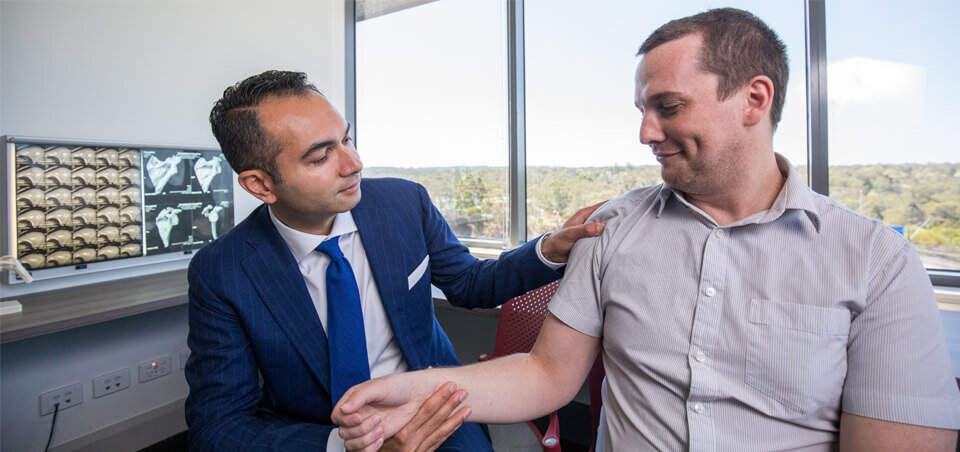Biceps Tendonitis and SLAP (superior labrum anterior and posterior) tears
Knowledge that empowers
What is it?
The biceps brachii (biceps) is a muscle on the front of the upper arm that assists in bending at the elbow, turning the forearm palms upwards and in moving the arm forward from the shoulder.
It has two attachments at the top of the humerus (upper arm bone) and another in the front of the elbow. The short head of biceps attaches via tendons to the coracoid (a small prominence on the front side of the shoulder blade) and the long head which passes through a groove in the upper humerus before travelling deep into the shoulder joint where it attaches into a ring of cartilage (the labrum) in the socket of the shoulder joint.
The tendon of the long head of biceps can become irritated from overuse and over time this may lead to degeneration or a tear within the tendon, which can be a cause of pain in the shoulder. The tendon may also be affected when there is a tear in the subscapularis tendon which lies close to the long head of biceps where the biceps tendon can dislodge through the tear in the subscapularis.
Sometimes there may be injury where the biceps tendon attaches to the labrum at the socket. This is known as a SLAP tear which refers to the portion of the labrum affected (Superior Labrum from Anterior Posterior). The feature that makes SLAP possible is the way the upper biceps tendon hooks over the head of the humerus. If the arm is forcefully bent inward and twists at the shoulder, the humeral head acts as a lever and tears the biceps tendon and labrum cartilage from the glenoid bone in a front-to-back (anterior-posterior) direction

Who is affected?
Younger people who perform repetitive overhead activities such as overhead jobs or overhead sports involving throwing motions with rotation/twisting including tennis, cricket or volleyball can develop tendonitis or a SLAP tear.
In older patients, the biceps tendon itself may become degenerative or torn, and may also be affected in conjunction with a tear of the rotator cuff.
What are the symptoms?
Pain and clicking is often felt at the top of the arm especially at the front of the shoulder and it may radiate a little downwards into the biceps region.
Carrying a weight such as a shopping bag or reaching upwards and overhead can cause pain. A SLAP tear may also make it uncomfortable to complete overhead tasks and you may notice a loss of power overhead or when throwing a ball overhead. The symptoms can be insidious and be present for a long time before diagnosis.
How is the diagnosis made?
A diagnosis is made by listening to the information you give related to the injury mechanism and symptoms.
A clinical examination will be performed including tests that would specifically load the biceps tendon and muscle.
To confirm the diagnosis imaging is required. A magnetic resonance imaging scan involving the use of contrast (dye) in the shoulder joint is needed to confirm a SLAP lesion as this can’t be seen on x-ray or ultrasound scan.
What is the prognosis?
Often the symptoms settle with avoiding the aggravating activities for a period of time along with a physiotherapy programme to improve movement and strength within your shoulder. Sometimes other treatments or surgery may be necessary to allow you to return to full function.
Non surgical treatment
Pain medication, rest from aggravating activities along with a graduated physiotherapy programme often allows people to return to normal activities.
If your symptoms are not settling a corticosteroid injection may be considered to reduce your symptoms enough to allow you to progress through your physiotherapy programme.
For throwing athletes, attention is required to local shoulder mechanics including range of motion and strength of the shoulder, as well as wider ‘kinetic chain’ issues (leg and trunk range of motion and strength), throwing technique, and throwing loads (volume, intensity and frequency).
Surgical treatment
It is recommended if an athlete wants to continue their sports and training. This involves arthroscopic (keyhole) surgery.
Tenotomy
One option is a biceps tenotomy. The biceps tendon is cut and the degenerative parts of the tendon are removed and trimmed.
Following surgery you may spend a few days in a sling for comfort before gradually building up your shoulder activities. Often the pain is completely resolved and strength in the shoulder is restored with physiotherapy. You will likely notice a bunching of the biceps muscle in the lower part of the arm over time (Popey sign), but it does not significantly affect its function. Most patients function very well without an intact long head of biceps tendon.
Tenodesis
A tenodesis is a similar procedure, however for cosmetic reasons the biceps tendon is reattached to a nearby point in the upper arm.
This results in a normal cosmetic appearance but has a very similar outcome to a tenodesis. Because of the time it takes for the anchor to knit into the bone after reattachment of the tendon, you will be in a sling and will not be able to lift anything heavy for around 4-6 weeks.
SLAP (labral) repair
Typically indicated for young athletes. The SLAP tear is repaired by a keyhole procedure where the detached area of labrum is repaired by way of small bone anchors.
A sling is worn for six weeks to allow for healing before you commence a graduated physiotherapy programme designed to restore movement, strength and function. You may need a period of time away from work or sport depending on your job or sport type. Your surgeon and physiotherapist will advise you when you can return to certain activities.
